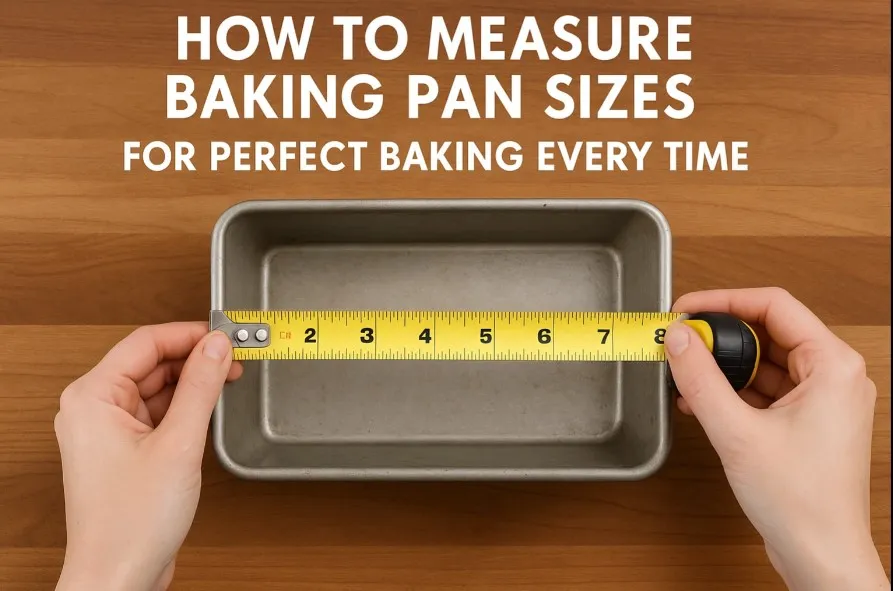Use a ruler to measure the pan’s length, width, and depth—or fill it with water to check capacity—ensuring your recipes bake evenly every time!
The first time I tried baking my grandma’s famous lemon loaf, it spilled over the sides and practically glued itself to my oven. Turns out, my pan was the wrong size—by more than a smidge. If you’ve ever wondered how serious pan size confusion can get, you’re not alone.

Let’s dive into the not-so-obvious art of measuring baking pans, decode all those odd dimensions, and figure out how to make any recipe work with the pans you actually own.
Cracking the Code: How to Actually Measure Baking Pan Sizes
If you’ve ever pulled a sunken cake or a “short” loaf out of the oven, you know the pain of misjudging baking pan sizes. I’ve been there—ruined cakes, overflowing batters, and that moment of confusion when a recipe’s results just don’t match the photo. It turns out, the secret isn’t just in the batter. It’s in the pan. And more specifically, how you measure it.

Let’s get real about Baking Pan Measurement Tips. The first thing I learned (the hard way) is that you should always measure from the inside edge to inside edge of your pan. Don’t trust the outside dimensions—pan thickness can throw everything off. Grab a ruler or measuring tape and place it inside the pan, right up against the inner walls. This gives you the true size, the one your recipe actually cares about.
But don’t stop there. Depth matters. I once made a delicate chiffon cake, only to watch it overflow because I’d forgotten to check the pan’s height. For accurate Pan Volume Measurement, measure the height from the inside bottom to the top edge. Volume can make or break a recipe—especially with cakes and breads that rise a lot.
- 8×4 inch loaf pan = 4 cups batter
- 9×5 inch loaf pan = 8 cups batter
- 6×2 inch round pan = 4 cups batter
Here’s a personal example: I once baked a lemon loaf in what I thought was a standard 9×5 pan. Turns out, it was actually an 8×4 pan. That’s a whole cup less in volume! The result? Batter overflowed, the loaf was “short,” and my kitchen needed a deep clean. Research shows that even a small difference in Baking Dish Sizes can drastically affect your results.
‘Baking is a science. Accuracy matters, even down to a quarter inch.’ – Rose Levy Beranbaum
So, whenever you’re prepping for a new recipe, take a moment to measure your pans the right way. Remember, it’s not just about length and width—height and volume are just as critical. These Baking Pan Measurement Tips can save your cakes, breads, and sanity.
Adventures in Pan Swapping: The Great Cake Pan Conversions
Let’s be honest—most home bakers don’t have a full arsenal of every possible baking pan size. I certainly don’t. That’s why understanding Cake Pan Sizes and smart Cake Pan Conversions is a game-changer in the kitchen. If you’ve ever stared at a recipe calling for a 9×3 inch tube pan but only found a 10×2.5 inch springform in your cupboard, you’re not alone. Here’s the good news: both pans actually hold about the same volume—12 cups. That means you can swap them out without risking a baking disaster.

There’s a method to this madness. It’s not just about matching the width and length; it’s about matching the volume. Research shows that a 9×3 inch tube pan equals roughly 12 cups, just like a 10×2.5 inch springform. But not all springform pans are created equal—a 9×2.5 inch version only holds 10 cups. That two-cup difference can mean the world when you’re pouring in batter and hoping for a perfect rise.
Let’s talk about Standard Baking Pan Sizes for a second. Jelly Roll Pans, for example, typically measure 10×15 or 12×17 inches. Half sheet pans are larger, usually 18×13 inches. I once tried swapping a jelly roll pan for a half sheet because I thought, “How different could it be?” The cookies turned out fine, but the fudge I poured on top? It melted right off the edge. Lesson learned: not all swaps are created equal, especially when it comes to pan depth and rim height.
Here’s a quick reference table for some common pan sizes and their capacities:
| Pan Type | Size | Volume |
|---|---|---|
| Tube Pan | 9×3 inch | 12 cups |
| Springform Pan | 10×2.5 inch | 12 cups |
| Springform Pan | 9×2.5 inch | 10 cups |
| Jelly Roll Pan | 10×15 or 12×17 inch | — |
| Half Sheet Pan | 18×13 inch | — |
‘A pan swap is like changing shoes for a marathon—fit is everything.’ – Dorie Greenspan
So, when you’re eyeing a recipe and your pan collection falls short, remember: volume is your best friend. Swapping pans works—if you know the right conversions.
Cheat Sheet: The Quick-Reference Table of Standard Baking Pan Sizes
If you’ve ever stood in your kitchen, recipe in hand, and wondered if your pan is the right size, you’re not alone. Standard Baking Pans come in a dizzying array of shapes and dimensions, and trust me—Sheet Pan Sizes matter more than you might think. It’s not just bakery jargon. The difference between a Half Sheet Pan and a Quarter Sheet Pan can determine whether your cookies come out perfectly golden or end up burnt around the edges.
Let’s get real: I once tried to use a Quarter Sheet Pan as a deep-dish pan. Spoiler alert—my brownies overflowed, and the cleanup was a nightmare. So, here’s my quick rundown of the most common Sheet Pan Dimensions and Baking Dish Sizes you’ll actually use at home. Stick this table to your fridge, and you’ll never second-guess your pan choice again.
| Pan Type | Dimensions (inches) | Common Uses |
|---|---|---|
| Full Sheet Pan | 18 x 26 | Large batch baking, catering |
| Half Sheet Pan | 18 x 13 | Cookies, roasting veggies |
| Quarter Sheet Pan | 9 x 13 | Brownies, small cakes |
| Eighth Sheet Pan | 9 x 6 | Mini bakes, toasting nuts |
| Square Pan | 8 x 8 | Brownies, bar cookies |
| Rectangular Pan | 9 x 13 | Casseroles, sheet cakes |
Research shows that the most common Standard Baking Pan Sizes for home bakers are the 8×8 inch square, 9×13 inch rectangular, and the 18×13 inch Half Sheet Pan. Always measure your pans from inside edge to inside edge—excluding the thickness of the pan itself—for the most accurate Sheet Pan Dimensions. It’s a simple step, but it can save your recipes from disaster.
You’ll also hear terms like jelly roll pan and cookie sheet thrown around. Here’s the subtle difference: a jelly roll pan is usually 10×15 inches with a rim all around, while a cookie sheet might only have one or two raised sides for easy sliding. These little details in Baking Dish Sizes can make a big difference in your results.
‘The humble sheet pan is the MVP of my kitchen.’ – Ina Garten
Wild Cards, Tangents & Pro Tips: Tube Pans, Cookie Sheets, and That One Pan You Always Ignore
Let’s get real for a moment: not all baking pans are created equal, and sometimes the quirkiest ones are the most important. I’ve learned the hard way that grabbing the wrong pan can turn a promising recipe into a kitchen disaster. Take tube pans, for example.
If you’ve ever tried to bake angel food cake in a regular round pan, you know it just doesn’t work. Tube pans—those with a hollow center—are designed to distribute heat evenly, giving delicate cakes like angel food and chiffon their signature airy texture. The standard 9×3 inch tube pan holds about 12 cups, and honestly, there’s no real substitute if you want that perfect rise.

Then there’s the cookie sheet versus baking sheet debate. It’s easy to overlook, but research shows the main difference is in the edges. Cookie sheets usually have one or two elevated sides, while baking sheets have a rim all the way around. That missing rim on a cookie sheet?
It’s great for sliding cookies off, but not so great for containing runny batters—trust me, I’ve cleaned the oven more than once because I ignored this detail. It’s a classic example of why understanding baking pan sizes and designs really matters.
Springform pans are another wild card. If you’ve ever baked a cheesecake, you know these pans are a lifesaver—until they leak. It’s almost a rite of passage for bakers: you line the bottom, wrap it in foil, and still, somehow, a little bit of precious batter escapes. As Christina Tosi puts it,
‘Every pan has a story. Some involve leaks.’
That’s the charm (and frustration) of springform pans. A standard 9×2.5 inch springform holds about 10 cups, making it a close cousin to the tube pan in volume, but with its own set of quirks.
And let’s not forget the pans we always ignore—like the jelly roll pan, which is perfect for thin cakes and roulades, but rarely gets the spotlight. Baking pan size comparison isn’t just trivia; it’s the difference between success and a soggy bottom. So next time you reach for a pan, remember: every shape, every size, every edge matters more than you think. Your bakes—and your sanity—depend on it.
Frequently Asked Questions
Can I use a different pan size than the recipe says?
Yes, but adjust baking time and watch for doneness. A bigger pan means thinner batter, which cooks faster.
How do I measure a springform pan?
Measure the diameter across the top, just like a round cake pan.
Does pan material affect baking?
Yes! Dark metal pans heat faster than light ones, so reduce oven temperature by 25°F to prevent over-browning.
What if my pan is deeper than standard?
Deeper pans may need extra baking time. Check the center for doneness before removing.
Pro Tips for Perfect Baking
- Grease pans well to prevent sticking.
- Use parchment paper for easy removal.
- Rotate pans halfway through baking for even heat distribution.
“Baking is about precision, but also about joy. Measure well, bake with love, and enjoy the results.” – Ina Garten
Conclusion
Knowing how to measure baking pan sizes is a simple but essential skill for every baker. Whether you’re making a birthday cake or weekend brownies, the right pan ensures perfect results every time. Keep this guide handy, and happy baking!

